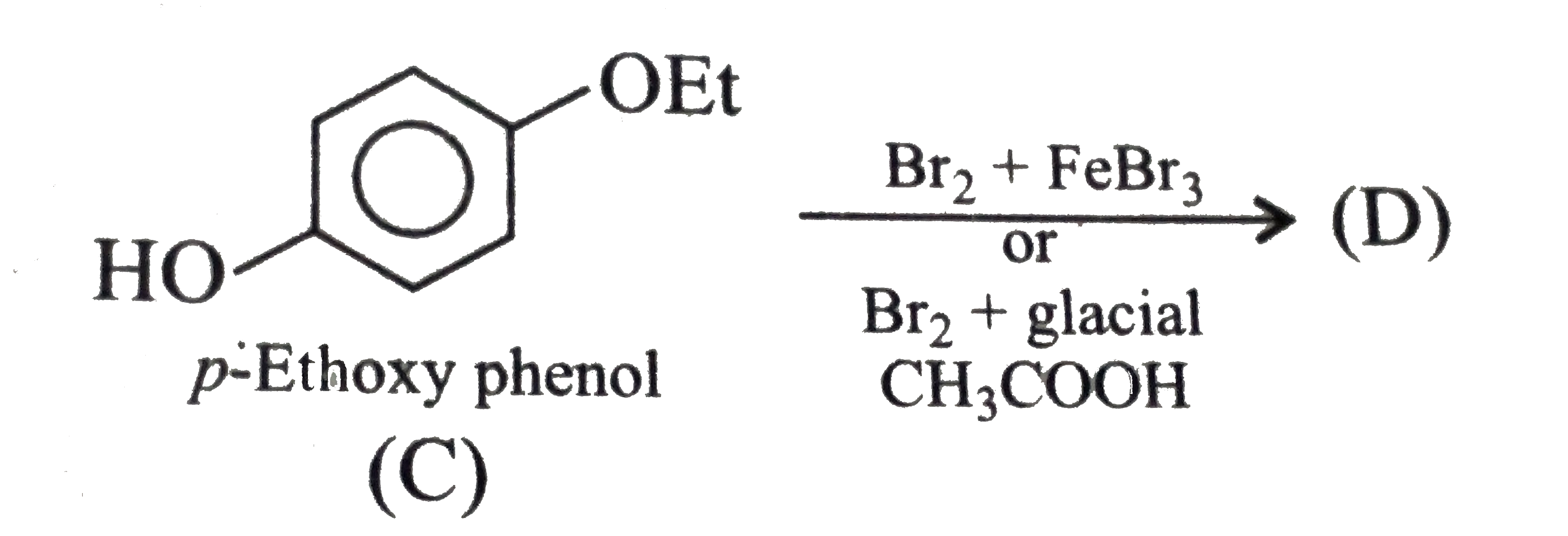a. Write the reaction of EtOH with (i) KNH2 (ii) aq. KOH (iii) Potassium ethynide.
b. Complete the following reaction:

c. Why is methanol more toxic than ethanol ? How is a methanol Poisoned patient treated ?
d. How does the ingestion of ethanol in low and high concentration affects the central nervous system ?
a.
i. K⊕NH⊕2+EtOH→NH3+etO−K⊕
ii. K⊕O−H+EtOH  H2O+EtO−K⊕
H2O+EtO−K⊕
iii. HC≡N−K⊕+EtOH→HC≡CH+EtO−K⊕
b.
c. MeOH [O]−−→ CH2=O [O]−−→ HCOOH
EtOH [O]−−→ MeCH=O [O]−−→ MeCOOH
The merabolism (biological oxidation) of both alcohols in the body produces corresponding aldehyde (methanal and ethanal) followed by acid (methanoic and ethanoic acid). The product from methanol is much more toxic than the product from ethanol. Methanal and methanoic acid may cause bindness and deth. A methanol posisoned patient is treated by giving intravenous infusion of diluted ethanol. The enzyme responsible for oxidation of aldehyde (HCHO) to acid is swamped, allowing kidneys to excreate methanol.
d. Ingestion of ethanol on the CNS (central nervous system). In small or moderate amount, it affects judgement and lowers inhibitions. Higher amount causes nausea and loss of consciopusness and interferes with spontaneous respairation and can be fatal.
Topper's Solved these Questions
- ALCOHOL,PHENOL AND ETHERSBOOK - CENGAGE CHEMISTRYCHAPTER - ALCOHOL,PHENOL AND ETHERSEXERCISE - Exercises Subjective
25 Videos
- ALCOHOL,PHENOL AND ETHERSBOOK - CENGAGE CHEMISTRYCHAPTER - ALCOHOL,PHENOL AND ETHERSEXERCISE - Exercises Concept Application
33 Videos
- ALCOHOL,PHENOL AND ETHERSBOOK - CENGAGE CHEMISTRYCHAPTER - ALCOHOL,PHENOL AND ETHERSEXERCISE - Archives Analytical And Descriptive
15 Videos
- ALIPHATIC AND AROMATIC ALDEHYDES AND KETONESBOOK - CENGAGE CHEMISTRYCHAPTER - ALIPHATIC AND AROMATIC ALDEHYDES AND KETONESEXERCISE - Archives Subjective
29 Videos
Similar Questions
(a) Write the reactions involved in the following :
(i) Etard reaction. (ii) Stephen reduction.
(b) How will you convert the following is not more than two steps :
(i) Benzoic acid to benzaldehyde. (ii) Acetophenone to benzoic acid.
(iii) Ethanoic acid to 2-hydroxyethenoic acid.
View Solution(a) Write the reactions involved in the following:
(i) Etard reaction
(ii) Stephen reduction
(b) How will you convert the following in not more than two steps:
(i) Benzoic acid to Benzaldehyde
(ii) Acetophenone to Benzoic acid
(iii) Ethanoic acid to 2-Hydroxyethanoic acid.
View Solution(a) Write the reactions involved in the following:
(i) Etard reaction
(ii) Stephen reduction
(b) How will you convert the following in not more than two steps:
(i) Benzoic acid to Benzaldehyde
(ii) Acetophenone to Benzoic acid
(iii) Ethanoic acid to 2-Hydroxyethanoic acid.
View Solution(a) An organic compound (A) having molecular formula C4H8O gives orange red precipitate with 2, 4-DNP reagent. It does not reduce Tollens' reagent but gives yellow precipitate of iodoform on heating with NaOH and I2. Compound (A) on reduction with NaBH4 gives compound (B) which undergoes dehydration reaction on heating with cone. H2SO4 to form compound (C). Compound (C) on ozonolysis gives two molecules of ethanal.
Identify (A), (B) and (C) and write their structures. Write the reactions of compound (A) with (i) NaOH/I2 and (ii) NaBH4.
(b) Give reasons :
(i) Oxidation of propanal is easier than propanone.
(ii) α-hydrogen of aldehydes and ketones is acidic in nature.
Or
(a) Draw structures of the following derivatives :
(i) Cyanohydrin of cyclobutanone
(ii) Hemiacetal of ethanal
(b) Write the major product(s) in the following :
(i) CH3−CH=CH−CH2−CN(i)DIBAL−H−−−−−−−−−−−→(ii)H3O+<br>(ii)CH_(3) - CH_(2) - OH overset(CrO_(2)) (to)
(c) How can you distinguish between propanal and propanone ?
View Solutiona. Given the decreasing order of Lewis basicities of the following:
i. ii. C2H5−−O−−C2H5Dirthylether
ii. C2H5−−O−−C2H5Dirthylether
iii.
b. i. ii.
ii.  iii.
iii. 
c. Completer the following reaction :

d. (A) (B) Nitration−−−−−→
(B) Nitration−−−−−→
e.
f. How are the ethers distinguished form alcohols ?
View Solution(i) How will you bring about following conversion? Write the concerned chemical equations:
(a) Ethanol to Ethene (b) Ethanol to Ethanoic acid.
(ii) Give one example with chemical equation for following reactions:
(a) Substitution reaction (b) saponification (c) combustion reaction.
View Solution(a) A reaction is second order in A and first order in B .
(i) Write the differential rate equation.
(ii) How is the rate affected on increasing the concentration of A three times?
(iii) How is the rate affected when the concentration of both A and B doubled?
(b) A first order reaction takes 40 minutes for 30% decomposition. Calculate t1/2 for this reaction. (Given log 1.428 = 0.1548)
View SolutionWrite the balanced chemical equations for the following reactions and identify the type of reaction in each case.
(a) Nitrogen gas is treated with hydrogen gas in the presence of a catalyst at 773 K to form ammonia gas.
(b) Sodium hydroxide solution is treated with acetic acid to form sodium acetate and water.
(c) Ethanol is warmed with ethanoic acid to form ethyl acetate in the presence of concentrated H2SO4.
(d) Ethane is burnt in the presence of oxygen to form carbon dioxide, water and releases heat and light.
View SolutionWrite the balanced chemical equations for the following reactions and identify the type of reaction in each case.
(a) Nitrogen gas is treated with hydrogen gas in the presence of a catalyst at 773 K to form ammonia gas.
(b) Sodium hydroxide solution is treated with acetic acid to form sodium acetate and water.
(c) Ethanol is warmed with ethanoic acid to form ethyl acetate in the presence of concentrated H2SO4.
(d) Ethane is burnt in the presence of oxygen to form carbon dioxide, water and releases heat and light.
View SolutionWrite the balanced chemical equations for the following reactions and identify the type of reaction in each case.
(a) Nitrogen gas is treated with hydrogen gas in the presence of a catalyst at 773 K to form ammonia gas.
(b) Sodium hydroxide solution is treated with acetic acid to form sodium acetate and water.
(c) Ethanol is warmed with ethanoic acid to form ethyl acetate in the presence of concentrated H2SO4.
(d) Ethane is burnt in the presence of oxygen to form carbon dioxide, water and releases heat and light.
View Solution
